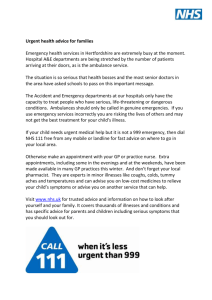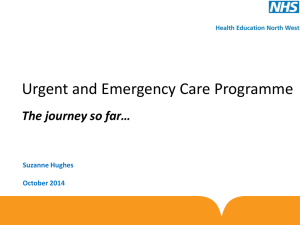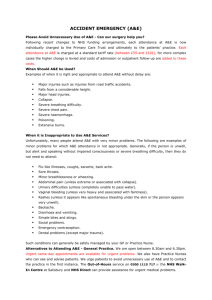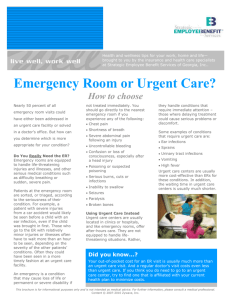DRAFT Urgent and Emergency Care Facilities Specifications
advertisement
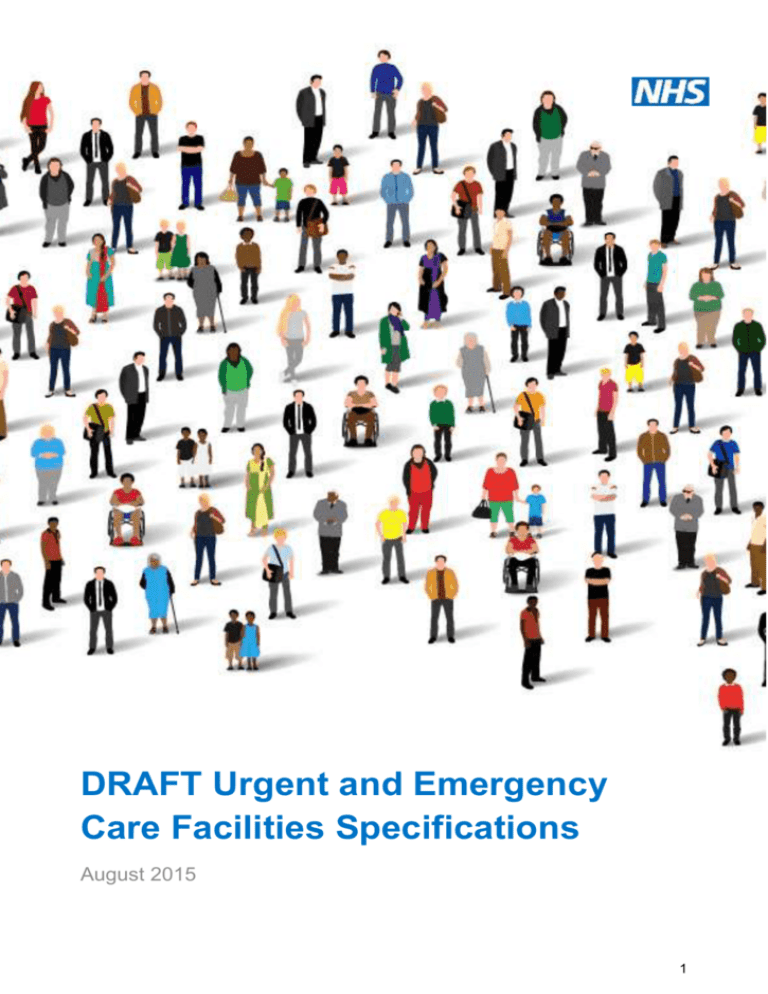
DRAFT Urgent and Emergency Care Facilities Specifications August 2015 1 Introduction This document outlines draft specifications to help the NHS in London deliver co-ordinated, consistent and high quality urgent and emergency care (U&EC) services. It includes specifications for the different types of facilities that function within U&EC networks (urgent care centres (UCC), emergency centres (EC), emergency centres with specialist services (ECSS)) and the U&EC system that links these facilities together. The primary audience of this document is commissioners and providers of health care services. Background The first stage of Professor Sir Bruce Keogh’s Urgent and Emergency Care review called for clarity and transparency in the offering of U&EC services to the public. It recommended the development of Urgent and Emergency Care Networks, and the designation of Urgent Care Centres, Emergency Centres and Major Emergency Centres (now referred to as Emergency Centres with specialist services). Since the publication of the review, national guidance has been produced outlining standards for the functioning of these U&EC services. An overview of this is provided in the table below. It is intended that U&EC Networks will use the guidance to designate U&EC services in their region, with recognition that the services will be tailored to meet the needs of local communities. Urgent Care Centres Community-based primary care facilities providing urgent care for a local population; Encompass Walk-in Centres, Minor Injuries Units, GP-led Health Centres and all other similar facilities – but now referred to as Urgent Care Centres; Act as an access point to the U&EC network 24/7; however, individual facilities not necessarily open 24/7 Recommended to be open and staffed consistently for at least 16 hours a day; Recommended to be co-located with emergency care centres on hospital sites. Emergency Centres Hospital facilities that are able to receive, assess, treat and refer all patients with urgent and emergency care needs; Include an emergency department which is under constant supervision of a team of consultants in emergency medicine – not necessarily always present but available to attend with 30 minutes Provide inpatient facilities to admit and investigate patients’ illnesses and injuries as well as having a range outpatient and supporting services. Emergency Centres with Specialist services Hospital based facilities with all the features of an EC, but also specialist facilities that receive patients from ECs, or directly from an ambulance which has bypassed an EC; Provide support and coordination to the whole network for patients with specialist emergency care needs; Provide consultant presence over extended hours; Provide immediate access to enhanced diagnostics such as CT and MRI scanning and interventional radiology, and a wider range of facilities. 2 Developing facilities specifications for London In London, this guidance has been supplemented and tailored to the region through the incorporation a wide range of existing standards and guidance, including the London quality standards for urgent and acute emergency services, specialist care standards (e.g. for stroke and major trauma), inter-hospital transfer standards and Mental Health Crisis Care Standards. In addition, a wide range of stakeholders have been engaged to date: Interim London Transformation Group U&EC Board U&EC Clinical Leadership Group (CLG) & Clinical Expert Group (CEG) Trust Development Authority (TDA) Clinical leads Healthy London Partnership programmes (NHS 111; Primary care; Children and Young people; Homelessness; Mental Health) SPG leads Strategic Clinical Networks and London Clinical Senate Forum System specification: One System, Multiple Services The long-term vision is to create an urgent and emergency care system that is capable of delivering the right care, first time for the majority of patients through a networked model 7 days a week, and which is easy for patients to navigate and understand. Past consultation has highlighted that the general public do not distinguish between urgent and emergency healthcare. The system is therefore required to provide clarity as to which services are provided where and robust pathways to access the appropriate service reliably 24/7. Engagement with the multiple stakeholders in London has echoed this and highlighted the need to provide a clear outline of a high quality, joined up system that is not confusing to the public or staff and is financially sustainable. For urgent care services, in particular, the formulisation of a system is required to ensure a full range of urgent care services are available to the public 24/7 without every facility open 24/7. To achieve this, in addition to outlining specifications for individual facilities, an U&EC system specification has been developed. The specification seeks to formalise the clinical interdependences between community-based services (general practice, NHS111, ambulance services and Urgent Care Centres), hospitals with Emergency Departments (Emergency Centres) and those with specialist services. It aims to enable the development of a single system that is greater than the sum of its parts; ensuring a joined up, seamless urgent care service. The specification outlines the consistency in the system for equitable U&EC provision regardless of whether initially accessed through 111, self-presentation or 999. It too has been developed based on stakeholder feedback and cross-reviewing a number of existing service standards. System operating hours Clinical governance Access to information Clinical assessment and transfer Integrated capacity management 111 Self-present 999 3 DRAFT Urgent and Emergency Care Service Specifications August 2015 Urgent Care Centres Specification Domain 1. Governance Specification i. Have a formal written policy for providing urgent care. This policy is to adhere to the urgent care clinical quality standards. The policy is to be ratified by the service’s provider board and the U&EC Network annually. i. Urgent care LQS 1 & Draft National guidance 2 ii. Be within an urgent and emergency care network. ii. Urgent care LQS 2 & Draft National guidance 1 iii. Have integrated clinical governance structures with Emergency centres, whether colocated or standalone. iv. All patient safety incidents are reported to the National Reporting and Learning System and reviewed locally to identify and implement learning. Similarly all National Patient Safety Alerts should be implemented in full and in the spirit they are intended. 2. Location Reference iii. Urgent care LQS 2 iv. Draft National guidance 18 v. Have an identified clinical lead, and participate in clinical and non-clinical audit, demonstrating effective engagement in a programme of continuous quality improvement. v. Draft National guidance 3 i. Community-based primary care facilities providing urgent care for a local population. i. Draft National guidance principle ii. Where possible, co-located with emergency centres. ii. Draft National guidance principle 3. Operating hours i. Open for a minimum of 16 hours per day. ii. Consistent in staffing and service provision throughout days and weeks. iii. During the hours that they are not open, provide immediate access to the Urgent and Emergency Care Network for persons contacting the Urgent Care Centre by phone (e.g. through 111, out of hours general practice, the ambulance service, or similar arrangements) or arriving in person. i. Draft National guidance principle ii. Draft National guidance principle iii. Draft National guidance 5 4 DRAFT Urgent and Emergency Care Service Specifications 4. Access 5. Staffing August 2015 i. Receive patients that present themselves at the centre. i. Addition ii. Contain the necessary facilities to receive electronic direct bookings from NHS 111. ii. Addition iii. Receive patient referrals from ambulance and other urgent and emergency services within agreed protocols and pathways of care iii. Draft National guidance 6 iv. Have direct access to assessment units and ambulatory care units within agreed protocols iv. Addition i. During the hours that they are open, staffed by multidisciplinary teams, including: at least one registered medical practitioner (either a registered GP or doctor with appropriate competencies (reflected below) for primary and emergency care), and at least one other registered healthcare practitioner. ii. All registered healthcare practitioners working in urgent care services to have a minimum level of competence in caring for adults, and children and young people including: (a) Basic life support; (b) Recognition of serious illness and injury; (c) Pain assessment; (d) Identification of vulnerable patients; (e) ability to recognise that someone may be experiencing a mental health problem and to respond appropriately and (f) awareness of safeguarding. At anytime the service is open at least one registered healthcare practitioner is to be trained and competent in advanced life support and paediatric advanced life support. iii. Have arrangements in place for staff to access support and advice from experienced doctors (ST4 and above or equivalent) in both adult and paediatric emergency medicine and other specialties including mental health and paediatrics within their network without necessarily requiring patients to be transferred to an emergency department or other service. i. Urgent care LQS 3 & Draft National Guidance 4 ii. Urgent care LQS 14 & Draft National guidance 8 & 9 with Mental health addition iii. Urgent care LQS 16, aligns with Draft National guidance 13 and with Mental health addition iv. Addition v. Draft national guidance 12 iv. Have arrangements in place for staff to access advice and support in relation to medications during hours UCC is open v. Have a medical or non-medical prescriber present throughout their hours of operation. PGDs to support the treatment of common injuries and illnesses may be used until sufficient staff are qualified as prescribers 5 DRAFT Urgent and Emergency Care Service Specifications 6. Safeguarding i. Access to a paediatrician with child protection experience and skills (of at least Level 3 safeguarding competencies) should be available to provide immediate advice and subsequent assessment, if necessary, for children and young people under 19 years of age where there are safeguarding concerns. The requirement is for advice, clinical assessment and the timely provision of an appropriate medical opinion, supported with a written report. August 2015 i. Paediatric Emergency Services LQS 22 ii. Addition ii. Safeguarding lead in place to take ownership of safeguarding governance and linking into system-wide arrangements. 7. Assessment & iii. Escalation protocol is to be in place to ensure that seriously ill/high risk patients Treatment presenting to an Urgent Care Centre are seen immediately by a registered healthcare practitioner, and where treatment in an Emergency Centre or Emergency Centre with specialist services is required this is facilitated by attendance from the ambulance service within agreed timescales iv. All patients are to be seen and receive an initial clinical assessment by a registered healthcare practitioner within 15 minutes of the time of arrival at the urgent care service. iii. Urgent care LQS 4 & Draft National guidance 7 iv. Urgent care LQS 5 v. Urgent care LQS 6 vi. Urgent care LQS 7 v. Within 90 minutes of the time of arrival at the urgent care service 95 per cent all patients are to have a clinical decision made that they will be treated in the urgent care service and discharged or arrangements made to transfer them to another service. vi. At least 95 per cent of patients who present at an urgent care service to be seen, treated if appropriate and discharged in under 3 hours of the time of arrival at the urgent care service (where clinically appropriate). 8. Diagnostics i. Access to the following diagnostics during hours the urgent care centre is open, with real time access to images and results: - Plain film x-ray: immediate access with formal report received by the urgent care service within 24 hours of examination - Blood testing: immediate on-site access with formal report received by urgent care service within one hour of the sample being taken i. Urgent care LQS 10 & Draft National guidance 11 6 DRAFT Urgent and Emergency Care Service Specifications August 2015 Clinical staff to have the competencies to assess the need for, and order, diagnostics and imaging, and interpret the results (where this is not currently available, local protocols should specify alternate routes of access and reporting standards). 9. Equipment i. Appropriate equipment to be available onsite (with relevant sizes available for adults and children where applicable): - a full resuscitation trolley an automated external defibrillator oxygen suction and emergency drugs i. Urgent care LQS 11 & Draft National guidance 10 ii. Urgent care LQS 12 All urgent care service to be equipped with a range of medications necessary for immediate treatment. ii. Urgent care services to have appropriate waiting rooms, treatment rooms and equipment according to the workload and patient’s needs and the environment should be child friendly. 10. Mental Health Crisis Care i. Single point of access for mental health referrals to be available during hours the urgent care service is open, with a maximum response time of 1 hour. i. Draft Urgent care LQS 17 ii. Dedicated area for mental health assessments which reflects the needs of people experiencing a mental health crisis and in accordance with RCPsych standards. ii. - v. London Mental Health Crisis standards and Mental Health Crisis Care Concordat iii. Arrangements in place to ensure Mental Health Act assessments take place promptly and reflect the needs of the individual concerned. iv. Access to all the information required to make decisions regarding crisis management including self-referral. v. Direct line of communication with local mental health service and knowledge of local out of hours mental health services vii. Paediatric Emergency Services LQS 21 vi. Single call access for children and adolescent mental health (CAMHS) (or adult mental health services with paediatric competencies for children over 12 years old) referrals to 7 DRAFT Urgent and Emergency Care Service Specifications August 2015 be available 24 hours a day, seven days a week with a maximum response time of 30 minutes. Psychiatric assessment to take place within four hours of call. 11. Transfer i. All patients are able to access the same integrated clinical pathways as if they had called NHS 111 or attended an Emergency Centre ii. All patients have an episode of care summary communicated to the patient’s GP practice by 08.00 the next day. For children the episode of care is to be communicated to their health visitor or school nurse, where known and appropriate, no later than 08.00 the second day. i. Addition ii. Urgent care LQS 13 & Draft National guidance 16 iii. Addition iii. All episode of care summaries, including any change in medication, to be communicated with patient’s community pharmacist. iv. Urgent care LQS 15 & Draft National guidance 14 iv. All registered healthcare practitioners working in urgent care services to have direct access to urgent referrals to specialist on-call services when necessary, and the right to refer those patients who they see within their scope of practice. v. London Inter hospital transfer standards v. Urgent care centres to be accountable for having and monitoring robust and cohesive policies for inter-hospital transfers (IHTs) that encompass the agreed pan-London standards. All hospitals to be linked into networks for clinically indicated IHTs http://www.londonhp.nhs.uk/wp-content/uploads/2014/12/FINAL-Adult-IHTstandards_updated.pdf vi. Addition vii. Addition vi. Have access to a mobile Directory of Services and direct booking facility. vii. Transfer to another U&EC facility to be in line with the U&EC system specification (below) 12. Patient information i. All Urgent Care Centres should have arrangements in place for staff to access an upto-date electronic patient care record and Summary Care Records. i. Draft National guidance 13 ii. During all hours that the urgent care service is open it is to provide guidance and support on how to register with a local GP. ii. Urgent care LQS 8 & Draft National guidance 15 iii. Addition 8 DRAFT Urgent and Emergency Care Service Specifications iii. Contain the necessary facilities to receive patient information (e.g. crisis or care plan, child/adult at risk status) as part of any electronic 111 referral directly to the clinician via the inter-operability toolkit (ITK). August 2015 iv. Addition iv. Information should be provided to patients to support self-care and advise patients of alternative sources of care – e.g. pharmacy 13. Patient experience i. Patient experience data to be captured, recorded and routinely analysed and acted on. Data is to be regularly reviewed by the board of the urgent care provider and findings are to be disseminated to all staff and patients. i. Urgent care LQS 18 & Draft National guidance 17 ii. All patients to be supported to understand their diagnosis, relevant treatment options, ongoing care and support by an appropriate clinician. ii. Urgent care LQS 19 iii. Where appropriate, patients to be provided with health and wellbeing advice and signposting to local community services where they can self-refer (for example, smoking cessation services and sexual health, alcohol and drug services). 14. Training i. Urgent care centre to provide appropriate supervision for training purposes including both educational supervision and clinical supervision. ii. All healthcare practitioners to receive training in the principles of safeguarding children, vulnerable and older adults and identification and management of child protection issues. All registered medical practitioners working independently to have a minimum of safeguarding training level 3. iii. Urgent care LQS 20 & Draft National guidance 19 i. Urgent care LQS 21 & Draft National guidance 20 ii. Urgent care LQS 22 & Draft National guidance 21 9 DRAFT Urgent and Emergency Care Service Specifications August 2015 Emergency Centres Specification Domain 1. Governance Specification i. Part of an identified U&EC Network, with integrated governance structures. Reference i. Draft National guidance 1 ii. Have a formal written policy for providing emergency care, and clear pathways of care, including acceptance and referral criteria, for all common emergency conditions within ii. Draft National the over-arching Strategic Network. This policy includes both physical and mental guidance 2 health, and will be ratified by the service’s provider board and the U&EC Network iii. Paediatric annually. Emergency Services iii. All hospital based settings seeing paediatric emergencies including emergency LQS 6 departments and short-stay paediatric units to have a policy to identify and manage an acutely unwell child. Trusts are to have local policies for recognition and escalation of the critical child and to be supported by a resuscitation team. All to be able to provide initial stabilisation for acutely unwell children at level 2 HDU pending retrieval to an appropriate facility. 2. Location i. Contains an Emergency Department that operates structurally and functionally within a supporting acute hospital. i. Draft National guidance 3 3. Operating hours i. Open 24 hours a day, 7 days a week. i. Draft National guidance principle ii. Adhere to the clinical co-dependency framework to ensure all services are available. ii. Clinical codependency framework 4. Staffing i. Under the continuous supervision and accountability of one or more consultants in Emergency Medicine. i. Draft National guidance principle ii. Emergency Department LQS 1 & 10 DRAFT Urgent and Emergency Care Service Specifications ii. A trained and experienced doctor (ST4 and above or doctor of equivalent competencies) in emergency medicine to be present in the emergency department 24 hours a day, seven days a week. iii. A consultant in emergency medicine to be scheduled to deliver clinical care in the emergency department for a minimum of 16 hours a day (matched to peak activity), seven days a week. Outside of these 16 hours, a consultant will be on-call and available to attend the hospital for the purposes of senior clinical decision making and patient safety within 30 minutes. iv. A designated nursing shift leader (Band 7) to be present in the emergency department 24 hours a day, seven days a week with provision of nursing and clinical support staff in emergency departments to be based on emergency department-specific skill mix tool and mapped to clinical activity. v. All emergency departments which see children to have a named paediatric consultant with designated responsibility for paediatric care in the emergency department. All emergency departments are to appoint a consultant with sub-specialty training in paediatric emergency medicine. Emergency departments to have in place clear protocols for the involvement of an on-site paediatric team. August 2015 adapted Draft National guidance 6 iii. Emergency Department LQS 2 & adapted Draft National guidance 5 iv. Emergency Department LQS 6 & adapted Draft National guidance 4 v. Paediatric Emergency Services LQS 2 vi. Paediatric Emergency Services LQS 8 vii. Addition vi. Hospital based settings seeing paediatric emergencies, emergency departments and viii. Addition short stay units to have a minimum of two paediatric trained nurses on duty at all times, (at least one of whom should be band 6 or above) with appropriate skills and competencies for the emergency area. vii. Timely access, seven days a week to, and support from, community nursing services including rapid response service integrated with social care provision, to support assessment of frail elderly and discharge. viii. Arrangements in place for staff to access advice and support in relation to medications. Including pharmacist presence in emergency department depending on local demand. 5. Safeguarding i. All children and young people, children’s social care, police and health teams have access to a paediatrician with child protection experience and skills (of at least Level 3 safeguarding competencies) available to provide immediate advice and subsequent i. Paediatric Emergency Services LQS 22 11 DRAFT Urgent and Emergency Care Service Specifications assessment, if necessary, for children and young people under 18 years of age where there are safeguarding concerns. The requirement is for advice, clinical assessment and the timely provision of an appropriate medical opinion, supported with a written report. August 2015 ii. Addition ii. Safeguarding lead in place to take ownership of safeguarding governance and linking into system-wide arrangements. 6. Access 7. Assessment/ Treatment/ Ambulatory i. Able to receive patients that present themselves at the centre i. Addition ii. Able to receive patients that present via Ambulance services ii. Addition i. 95 per cent of patients will wait less than 4 hours from arrival to admission, discharge or transfer. i. Department of health ii. Emergency Department LQS 5 ii. A clinical decision/ observation area is to be available to the emergency department for patients under the care of the emergency medicine consultant that require observation, iii. Emergency active treatment or further investigation to enable a decision on safe discharge or the Department LQS 7 need for admission under the care of an inpatient team. iv. Addition iii. Triage to be provided by a qualified healthcare professional and registration is not to v. Draft National delay triage. guidance 7 iv. Able to receive children and have the competencies to do so vi. Addition v. All Emergency Centres must have 24 hour access to blood products vi. Pharmacy – internal access or arrangements in place to safely access all medicines a patient needs in relation to the consultation at the time they need it. If required, these medicines to be available for a patient for at least a 24hour period 8. Diagnostics i. 24/7 access to the following minimum key diagnostics: - X-ray: immediate access with formal report received by the ED within 24 hours of examination - CT: immediate access with formal report received by the ED within one hour of examination i. Emergency Department LQS 3 & Draft National guidance 8 12 DRAFT Urgent and Emergency Care Service Specifications - Ultrasound: immediate access within agreed indications/ 12 hours with definitive report received by the ED within one hour of examination - Lab sciences: immediate access with formal report received by the ED within one hour of the sample being taken - Microscopy: immediate access with formal result received by the ED within one hour of the sample being taken August 2015 When hot reporting of imaging is not available, all abnormal reports are to be reviewed within 24 hours by an appropriate clinician and acted upon within 48 hours. 9. Equipment 10. Mental Health Crisis care i. The Emergency Department must include a resuscitation area with appropriate equipment to provide advanced paediatric, adult and trauma life support prior to transfer to definitive care. i. Addition i. Adhere to the Mental health crisis standards – http://www.crisiscareconcordat.org.uk/inspiration/nhs-london-strategic-clinicalnetworks-london-mental-health-crisis-commissioning-standards/ i. London Mental Health Crisis standards and Mental Health Crisis Care Concordat - Dedicated area for mental health assessments which reflects the needs of people experiencing a mental health crisis and in accordance with RCPsych standards. - Have access to on-site liaison psychiatry services 24 hours a day, 7 days a week. - Liaison Psychiatry services to see service users within 1 hour of ED referral - Arrangements in place to ensure Mental Health Act assessments take place promptly and reflect the needs of the individual concerned. - Access to all the information required to make decisions regarding crisis management including self-referral. ii. Paediatric Emergency Services LQS 21 ii. Single call access for children and adolescent mental health (CAMHS) (or adult mental health services with paediatric competencies for children over 12 years old) referrals to be available 24 hours a day, seven days a week with a maximum response time of 30 minutes. Patient ED episode to be completed including psychiatric assessment within four hours of call. 13 DRAFT Urgent and Emergency Care Service Specifications 11. Transfer i. Following initial stabilisation some patients who require specialist care will be transferred to another Emergency Centre or a Specialist Emergency Centre; this transfer capability is integral to the functioning of an Emergency Centre and the network in which it operates. August 2015 i. Draft National guidance principle ii. Emergency Department LQS 4 ii. Emergency department patients who have undergone an initial assessment and iii. Emergency management by a clinician in the emergency department and who are referred to Department LQS 9 another team, to have a management plan (including the decision to admit or iv. Inter hospital transfer discharge) within one hour from referral to that team. When the decision is taken to standards & National admit a patient to a ward/ unit, actual admission to a ward/ unit to take place within one guidance 11 & 12 hour of the decision to admit. If admission is to an alternative facility the decision maker is to ensure the transfer takes place within timeframes specified by the London v. Addition inter-hospital transfer standards (See below link). vi. Addition iii. Timely access, seven days a week to, and support from, onward referral clinics and vii. Addition efficient procedures for discharge from hospital. iv. Trusts to be accountable for having and monitoring robust and cohesive policies for inter-hospital transfers (IHTs) - including repatriations – that encompass the agreed pan-London standards – adult and paediatric. All hospitals to be linked into networks for clinically indicated IHTs - http://www.londonhp.nhs.uk/wpcontent/uploads/2014/12/FINAL-Adult-IHT-standards_updated.pdf v. Transfer to another U&EC facility to be in line with the U&EC system specification (below) vi. Formal arrangement in place linking to community service teams vii. Have access to a mobile Directory of Services and direct booking facility. 12. Clinical support services i. All Emergency Centres must have 24 hour access to care or advice from all specialties, including mental health, directly or through the Network (in some cases this may be provided remotely, for example using telemedicine) ii. Emergency departments to have a policy in place to access support services seven days a week including: - Alcohol liaison - Mental health - Older people’s care Safeguarding - Social services. i. Draft National guidance 9 ii. Emergency Department LQS 8 14 DRAFT Urgent and Emergency Care Service Specifications iii. Timely access, seven days a week to, and support from, community nursing services including rapid response services integrated with social care provision, physiotherapy and occupational therapy teams to support discharge. 13. Inpatient i. Adhere to the following London Quality Standards August 2015 iii. Emergency Department LQS 10 i. Range of LQSs - Acute medicine and emergency general surgery http://www.londonhp.nhs.uk/services/quality-and-safety-programme/acutemedicine-and-emergency-general-surgery/ ii. London clinical dependency framework - Paediatric Emergency Services - http://www.londonhp.nhs.uk/wpcontent/uploads/2013/03/PES-standards_FINAL-Feb2013.pdf iii. Draft National guidance 20 - Critical care - http://www.londonhp.nhs.uk/services/quality-and-safetyprogramme/critical-care/ - Fractured neck of femur pathway - http://www.londonhp.nhs.uk/services/qualityand-safety-programme/fractured-neck-of-femur-pathway/ - Maternity services - http://www.londonhp.nhs.uk/services/quality-and-safetyprogramme/maternity-services/ ii. Adhere to the London clinical dependency framework http://www.londonhp.nhs.uk/services/quality-and-safety-programme/clinicaldependencies-framework/ iii. All Emergency Centres must include facilities for ambulatory care, admission avoidance, early supported discharge and a frailty pathway 14. Patient information i. IT system for tracking patients, integrated with order communications. A reception facility with trained administrative capability to accurately record patients into the emergency department to be available 24 hours a day, seven days a week. Attendance and admission record and discharge summaries to be immediately available in case of re-attendance and monitored for data quality. ii. Ability to receive information via the inter-operability toolkit i. (Based on) Emergency Department LQS 11 ii. Addition iii. Addition iv. Addition v. Addition 15 DRAFT Urgent and Emergency Care Service Specifications August 2015 iii. Have access to Summary Care Records and care plans including crisis care and end of life. iv. Contain the necessary facilities to receive patient information from NHS 111 v. Information should be provided to patients to support self-care and advise patients of alternative sources of care – e.g. pharmacy 15. Patient experience i. Consultant-led communication and information to be provided to patients and to include the provision of patient information leaflets. i. Emergency Department LQS 13 ii. Patient experience data to be captured recorded and routinely analysed and acted on. Review of data is a permanent item on the trust board agenda and findings are disseminated. ii. Emergency Department LQS 14 iii. Consistent and clear information should be readily available to children and their families and carers regarding treatment and ongoing care and support. 16. Training iii. Paediatric Emergency Services LQS 25 i. The emergency centre to provide a supportive training environment and all staff to undertake relevant ongoing training. i. Emergency Department LQS 12 ii. Organisations have the responsibility to ensure that staff involved in the care of children and young people are appropriately trained in a supportive environment and undertake ongoing training. ii. Paediatric Emergency Services LQS 23 iii. All nurses looking after children to be trained in acute assessment of the unwell child, pain management and communication, and have appropriate skills for resuscitation and safeguarding. Training to be updated on an annual basis. iii. Paediatric Emergency Services LQS 24 16 DRAFT Urgent and Emergency Care Service Specifications August 2015 Emergency Centres with Specialist Services Specification Emergency Centres with Specialist services will provide all the features of an EC, but also specialist facilities. These additions are outlined below. Domain 1. Governance Specification Reference i. Provide support and coordination to the whole Network for patients with specialist emergency care needs, and work in partnership with the other system components to ensure that patients are able to access specialist care in a timely way. i. Draft National guidance principle ii. Addition ii. Protocols across networks should be in place with London Ambulance Service in regards to who should be conveyed to a Specialist Emergency Centre. 2. Staffing i. Provide consultant presence over extended hours. ii. Provide staffing in line with agreed specialist specifications. i. Draft National guidance principle ii. See below 3. Assessment/ Treatment i. Receive patients identified with specialist needs, either from ambulances that have bypassed an Emergency Centre or patients transferred from Emergency Centre in line with agreed protocols. i. Draft National guidance principle 4. Diagnostics i. Provide24/ 7 immediate access to enhanced diagnostics such as CT and MRI scanning and interventional radiology, and a wider range of facilities. i. Draft National guidance principle 5. Transfer i. Transfer from a Specialist Emergency Centre will be rare, other than for recovering patients being returned to community based settings of care, closer to patients’ homes or based on agreed protocols for specialist services. i. Draft National guidance principle ii. Inter-hospital transfer ii. As per the Inter-hospital Transfer standards – adult and paediatric: - If a specialist centre is unable to accept an IHT on clinical grounds clear reasons for the decision and targeted advice on further care must be provided 17 DRAFT Urgent and Emergency Care Service Specifications August 2015 to the sending hospital. The name of the specialist giving advice should be recorded in the patient’s medical notes at the sending hospital. - Where a specialist centre within a network lacks capacity to take an IHT within appropriate timescale, the specialist centre is responsible for finding an alternative destination for the patient - The specialist centre receiving a patient is to inform the sending hospital with the estimated date of discharge/repatriation as soon as possible, and no later than 48 hours from admission. i. Contains one of more specialist facilities and expertise – likely to fall within the remit of specialised commissioning (outlined below). i. Draft National guidance principle a. Major Trauma i. Adhere to standards for Major Trauma Centres. http://www.londonhp.nh s.uk/services/majortrauma/ b. HyperAcute Stroke Units i. Adhere to standards for Hyper-Acute Stroke Units. http://www.londonhp.nh s.uk/services/stroke/ c. Heart Attack Centres i. Adhere to standards for Heart Attack Centres. http://www.england.nhs. uk/wpcontent/uploads/2013/0 6/a09-cardi-primpercutaneous.pdf d. Vascular Centres i. Adhere to standards for specialised vascular services. http://www.england.nhs. uk/wpcontent/uploads/2013/0 6/a04-spec-vascuadult.pdf 6. Specialist care 18 DRAFT Urgent and Emergency Care Service Specifications August 2015 Urgent and Emergency Care System Specification This specification applies to all urgent and emergency care services. Domain Specification 1. System operating hours i. Telephone and in-person urgent and emergency care services are available 24 hours a day, 7 days a week at a System Resilience Group (SRG) level. 2. Clinical governance framework i. Nested integrated clinical governance arrangements joining all urgent care services are in place to assure the clinical quality of the patient pathway when accessing urgent care services and so issues can be identified and service improvements made. ii. Patient experience of moving within the urgent care system is captured and routinely analysed and acted on. This data is regularly communicated and reviewed by all urgent care services. iii. Safeguarding governance arrangements in place including regular system meetings. IT system flags and process to share additional information. 3. Access to information i. All services have access to patient’s Summary Care Records (SCR). This is a copy of key information held in GP records and includes knowledge about patients’ contact history and medical problems. ii. All services have access to care plans including crisis care and end of life. Patients with a specific care plan are treated according to that plan and, where patients have specific needs are transferred to the appropriate professional or specialist service. iii. All services have access to a mobile Directory of services and are responsible for informing NHS 111 of updates to the DoS when appropriate. iv. At every access point within the system information should be provided to patients to support self-care and advise of alternative sources of care – e.g. pharmacy 19 DRAFT Urgent and Emergency Care Service Specifications August 2015 4. Clinical i. Regardless of initial urgent care service access, patients are able to access the same integrated clinical assessment and pathways across the health and social care system. transfer ii. All urgent care services are able to make direct bookings to other services, as close to their location as possible for: a. Patients that require escalated clinical assessment and treatment b. Access to diagnostics that are not available within the current setting. c. Access to a community service/ social care iii. All services to have access to OOH clinical hubs for Dental and pharmacy services. iv. Where a referral is not made through a direct appointment, a robust referral process must be put in place and agreed by all services involved. v. A minimum data set of information on initial assessment should be agreed and accompany a referral and direct booking. vi. Patients that are transferred to an alternative urgent care service are not required to present at that service as a new patient. vii. At every facility all patients to have an episode of care summary communicated to the patient’s GP practice by 08.00 the next day. For children the episode of care is to be communicated to their health visitor or school nurse, where known and appropriate, no later than 08.00 the second day. 5. Integrated Capacity Management i. Integrated capacity management protocols are in place across the system, including access to real-time capacity information. 6. Training ii. Staff rotations should be in place across the U&EC system 20
